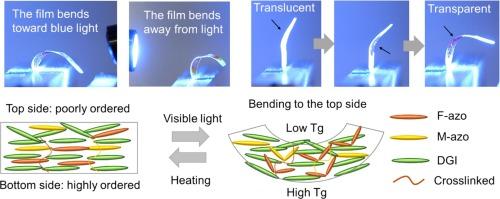Visible-light-switchable glass transition temperatures and optical actuation in crosslinked fluoroazopolymers
IF 5.8
2区 化学
Q1 POLYMER SCIENCE
引用次数: 0
Abstract
Nature has provided significant inspiration for designing polymer materials that can move in response to light, with many examples of such materials created, especially using ultraviolet (UV) light as an external stimulus. However, it is essential to design materials that can regulate the mechanical properties of polymers through visible light stimulation and macroscale movement under visible light exposure. Here, we have developed a polymer film chemically crosslinked with fluorinated azobenzenes, which produces a strong mechanical response when exposed to green or blue light in air. The film exhibits visible-light-switchable mechanical properties and directional bending due to the photoisomerization of azo chromophores in the crosslinked polymer networks. The thin film also changes their optical transparency upon visible light irradiation. This work offers insights into the development of responsive polymer materials and photomechanical materials, advancing the realization of self-propelled machines and soft robotics powered by visible light.

可见光可切换玻璃化转变温度和交联氟唑聚合物中的光学致动作用
大自然为设计能随光移动的聚合物材料提供了重要灵感,并创造了许多此类材料的实例,尤其是利用紫外线(UV)作为外部刺激。然而,必须设计出能够通过可见光刺激调节聚合物机械特性的材料,并在可见光照射下实现宏观运动。在这里,我们开发了一种与氟化偶氮苯化学交联的聚合物薄膜,当它暴露在空气中的绿光或蓝光下时,会产生强烈的机械响应。由于交联聚合物网络中的偶氮发色团发生了光异构化,这种薄膜具有可在可见光下切换的机械特性和方向性弯曲。在可见光照射下,薄膜的光学透明度也会发生变化。这项研究为开发响应性聚合物材料和光机械材料提供了新的视角,推动了以可见光为动力的自走式机器和软机器人的实现。
本文章由计算机程序翻译,如有差异,请以英文原文为准。
求助全文
约1分钟内获得全文
求助全文
来源期刊

European Polymer Journal
化学-高分子科学
CiteScore
9.90
自引率
10.00%
发文量
691
审稿时长
23 days
期刊介绍:
European Polymer Journal is dedicated to publishing work on fundamental and applied polymer chemistry and macromolecular materials. The journal covers all aspects of polymer synthesis, including polymerization mechanisms and chemical functional transformations, with a focus on novel polymers and the relationships between molecular structure and polymer properties. In addition, we welcome submissions on bio-based or renewable polymers, stimuli-responsive systems and polymer bio-hybrids. European Polymer Journal also publishes research on the biomedical application of polymers, including drug delivery and regenerative medicine. The main scope is covered but not limited to the following core research areas:
Polymer synthesis and functionalization
• Novel synthetic routes for polymerization, functional modification, controlled/living polymerization and precision polymers.
Stimuli-responsive polymers
• Including shape memory and self-healing polymers.
Supramolecular polymers and self-assembly
• Molecular recognition and higher order polymer structures.
Renewable and sustainable polymers
• Bio-based, biodegradable and anti-microbial polymers and polymeric bio-nanocomposites.
Polymers at interfaces and surfaces
• Chemistry and engineering of surfaces with biological relevance, including patterning, antifouling polymers and polymers for membrane applications.
Biomedical applications and nanomedicine
• Polymers for regenerative medicine, drug delivery molecular release and gene therapy
The scope of European Polymer Journal no longer includes Polymer Physics.
 求助内容:
求助内容: 应助结果提醒方式:
应助结果提醒方式:


